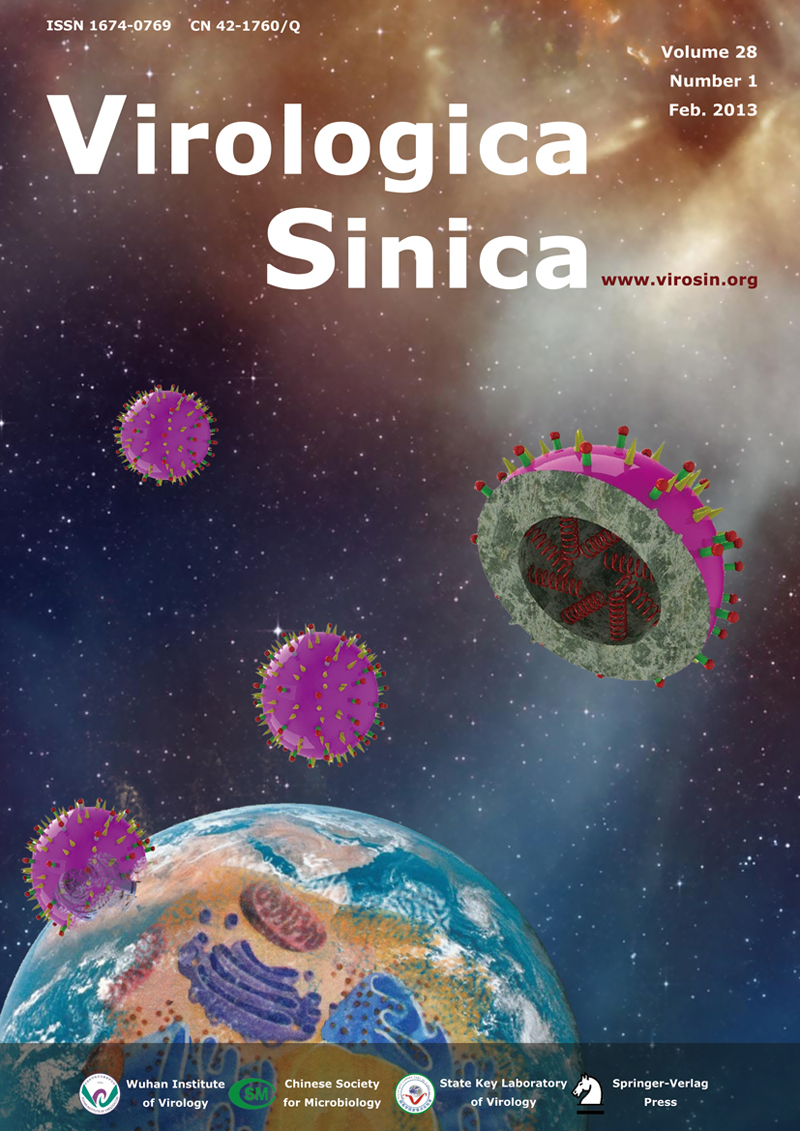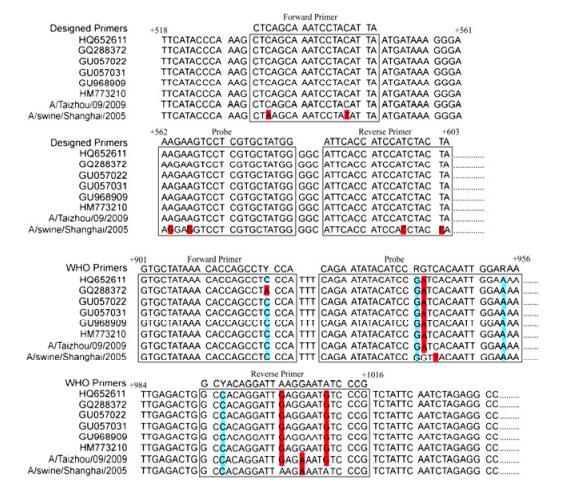-
Amano Y and Cheng Q. 2005. Detection of influenza virus: traditional approaches and development of biosensors. Anal Bioanal Chem, 381: 156-164.
doi: 10.1007/s00216-004-2927-0
-
Bennett S, Gunson R N, MacLean A, Miller R and Carman W F. 2010. The validation of a real-time RT-PCR assay which detects influenza A and types simultaneously for influenza A H1N1 (2009) and oseltamivir-resistant (H275Y) influenza A H1N1 (2009). J Virol Methods, 171: 86-90.
-
Burns N, Grimwade B, Ross-Macdonald P B, Choi E Y, Finberg K, Roeder G S and Snyder M. 1994. Large-scale analysis of gene expression, protein localization and gene disruption in Saccharomyces cerevisiae. Genes Dev, 8: 1087-1105.
doi: 10.1101/gad.8.9.1087
-
Cao B, Li X W, Mao Y, Wang J, Lu H Z, Chen Y S, Liang Z A, Liang L, Zhang S J, Zhang B, Gu L, Lu L H, Wang D Y and Wang C. 2009. Clinical features of the initial cases of 2009 pandemic influenza A (H1N1) virus infection in China. N Engl J Med, 361: 2507-2517.
doi: 10.1056/NEJMoa0906612
-
Chiu C Y, Urisman A, Greenhow T L, Rouskin S, Yagi S, Schnurr D, Wright C, Drew W L, Wang D, Weintrub P S, Derisi J L and Ganem D. 2008. Utility of DNA microarrays for detection of viruses in acute respiratory tract infections in children. J Pediatr, 153: 76-83.
doi: 10.1016/j.jpeds.2007.12.035
-
Dawson E D, Moore C L, Dankbar D M, Mehlmann M, Townsend M B, Smagala J A, Smith C B, Cox N J, Kuchta R D and Rowlen K L. 2007. Identification of A/H5N1 influenza viruses using a single gene diagnostic microarray. Anal Chem, 79: 378-384.
doi: 10.1021/ac061920o
-
Garten R J, Davis C T, Russell C A, Shu B, Lindstrom S, Balish A, Sessions W M, Xu X, Skepner E, Deyde V, Okomo-Adhiambo M, Gubareva L, Barnes J, Smith C B, Emery S L, Hillman M J, Rivailler P, Smagala J, de Graaf M, Burke D F, Fouchier R A, Pappas C, Alpuche-Aranda C M, Lopez-Gatell H, Olivera H, Lopez I, Myers C A, Faix D, Blair P J, Yu C, Keene K M, Dotson P D, Jr., Boxrud D, Sambol A R, Abid S H, St George K, Bannerman T, Moore A L, Stringer D J, Blevins P, Demmler-Harrison G J, Ginsberg M, Kriner P, Waterman S, Smole S, Guevara H F, Belongia E A, Clark P A, Beatrice S T, Donis R, Katz J, Finelli L, Bridges C B, Shaw M, Jernigan D B, Uyeki T M, Smith D J, Klimov A I and Cox N J. 2009. Antigenic and genetic characteristics of swine-origin 2009 A(H1N1) influenza viruses circulating in humans. Science, 325: 197-201.
doi: 10.1126/science.1176225
-
Ghedin E, Laplante J, DePasse J, Wentworth D E, Santos R P, Lepow M L, Porter J, Stellrecht K, Lin X, Operario D, Griesemer S, Fitch A, Halpin R A, Stockwell T B, Spiro D J, Holmes E C and St George K. 2011. Deep sequencing reveals mixed infection with 2009 pandemic influenza A (H1N1) virus strains and the emergence of oseltamivir resistance. J Infect Dis, 203: 168-174.
doi: 10.1093/infdis/jiq040
-
Gu H, Qi X, Li X, Jiang H, Wang Y, Liu F, Lu S, Yang Y and Liu F. 2010. Rapid and specific detection of H3 swine influenza virus using reverse transcription loop-mediated isothermal amplification method. J Appl Microbiol, 108: 1145-1154.
doi: 10.1111/jam.2010.108.issue-4
-
Gunson R, Maclean A, Davies E, Bennett S, Miller R and Carman W F. 2010. Development of a multiplex real-time RT-PCR that allows universal detection of influenza A viruses and simultaneous typing of influenza A/H1N1/2009 virus. J Virol Methods, 163: 258-261.
doi: 10.1016/j.jviromet.2009.10.006
-
Hata M, Tsuzuki M, Goto Y, Kumagai N, Harada M, Hashimoto M, Tanaka S, Sakae K, Kimura T, Minagawa H and Miyazaki Y. 2007. High frequency of amantadine-resistant influenza A (H3N2) viruses in the 2005-2006 season and rapid detection of amantadine-resistant influenza A (H3N2) viruses by MAMA-PCR. Jpn J Infect Dis, 60: 202-204.
-
Hoffmann E, Stech J, Guan Y, Webster R G and Perez D R. 2001. Universal primer set for the full-length amplification of all influenza A viruses. Arch Virol, 146: 2275-2289.
doi: 10.1007/s007050170002
-
Jiang T, Kang X, Deng Y, Zhao H, Li X, Yu X, Yu M, Qin E, Zhu Q, Yang Y and Qin C. 2010. Development of a real-time RT-PCR assay for a novel influenza A (H1N1) virus. J Virol Methods, 163: 470-473.
doi: 10.1016/j.jviromet.2009.09.021
-
Klungthong C, Chinnawirotpisan P, Hussem K, Phonpakobsin T, Manasatienkij W, Ajariyakhajorn C, Rungrojcharoenkit K, Gibbons R V and Jarman R G. 2010. The impact of primer and probe-template mismatches on the sensitivity of pandemic influenza A/H1N1/2009 virus detection by real-time RT-PCR. J Clin Virol, 48: 91-95.
doi: 10.1016/j.jcv.2010.03.012
-
Li X, Qi X, Miao L, Wang Y, Liu F, Gu H, Lu S, Yang Y and Liu F. 2009. Detection and subtyping of influenza A virus based on a short oligonucleotide microarray. Diagn Microbiol Infect Dis, 65: 261-270.
doi: 10.1016/j.diagmicrobio.2009.07.016
-
Lorusso A, Faaberg K S, Killian M L, Koster L and Vincent A L. 2010. One-step real-time RT-PCR for pandemic influenza A virus (H1N1) 2009 matrix gene detection in swine samples. J Virol Methods, 164: 83-87.
doi: 10.1016/j.jviromet.2009.12.002
-
Nicholls H. 2006. Pandemic influenza: the inside story. PLoS Biol, 4: e50.
doi: 10.1371/journal.pbio.0040050
-
Pabbaraju K, Wong S, Wong A A, Appleyard G D, Chui L, Pang X L, Yanow S K, Fonseca K, Lee B E, Fox J D and Preiksaitis J K. 2009. Design and validation of real-time reverse transcription-PCR assays for detection of pandemic (H1N1) 2009 virus. J Clin Microbiol, 47: 3454-3460.
doi: 10.1128/JCM.01103-09
-
Palese P and Shaw M L. 2007. Orthomyxoviridae: The Viruses and Their Replication, p. 1648-1689. In Knipe D M, Howley P M, Griffin D E, et al. (ed.), Fields Virology. Lippincott-William & Wilkins, Philadelphia, Pa.
-
Qi X, Li X, Rider P, Fan W, Gu H, Xu L, Yang Y, Lu S, Wang H and Liu F. 2009. Molecular characterization of highly pathogenic H5N1 avian influenza A viruses isolated from raccoon dogs in China. PLoS One, 4: e4682.
-
Salomon N and Perlman D C. 1999. Cytomegalovirus pneumonia. Semin Respir Infect, 14: 353-358.
-
Schulze M, Nitsche A, Schweiger B and Biere B. 2010. Diagnostic approach for the differentiation of the pandemic influenza A(H1N1)v virus from recent human influenza viruses by real-time PCR. PLoS One, 5: e9966.
doi: 10.1371/journal.pone.0009966
-
Spackman E, Senne D A, Myers T J, Bulaga L L, Garber L P, Perdue M L, Lohman K, Daum L T and Suarez D L. 2002. Development of a real-time reverse transcriptase PCR assay for type A influenza virus and the avian H5 and H7 hemagglutinin subtypes. J Clin Microbiol, 40: 3256-3260.
doi: 10.1128/JCM.40.9.3256-3260.2002
-
Storch G A. 2000. Essentials of diagnostic virology, 1st Edition ed. Churchill Livingstone, New York.
-
Vijaykrishna D, Poon L L, Zhu H C, Ma S K, Li O T, Cheung C L, Smith G J, Peiris J S and Guan Y. 2010. Reassortment of pandemic H1N1/2009 influenza A virus in swine. Science, 328: 1529.
doi: 10.1126/science.1189132
-
World Health Organization. 2009. http://www.who.int/csr/don/2009_11_13/en/index.html. World Health Organization.
-
World Health Organization. 2009. CDC Protocol of Realtime RTPCR for Influenza A (H1N1). World Health Organization.
-
World Health Organization. 2010. http://www.who.int/mediacentre/news/statements/2010/h1n1_vpc_20100810/en/index.html. World Health Organization.
-
Wright P F, Newmann G and Kawaoka Y. 2007. Orthomyxoviruses, p. 1693-1740. In Knipe D M, Howley P M, Griffin D E, et al. (ed.), Fields Virology. Lippincott-William & Wilkins, Philadelphia, Pa.
-
Wu C, Cheng X, He J, Lv X, Wang J, Deng R, Long Q and Wang X. 2008. A multiplex real-time RT-PCR for detection and identification of influenza virus types A and B and subtypes H5 and N1. J Virol Methods, 148: 81-88.
doi: 10.1016/j.jviromet.2007.10.023
-
Yang Y, Huang F, Gonzalez R, Wang W, Lu G, Li Y, Vernet G, Jin Q and Wang J. 2011. Evaluation of twelve real-time reverse transcriptase PCR primer-probe sets for detection of pandemic influenza A/H1N1 2009 virus. J. Clin. Microbiol., 49: 1434-1440.
doi: 10.1128/JCM.01914-10
-
Yongfeng H, Fan Y, Jie D, Jian Y, Ting Z, Lilian S and Jin Q. 2011. Direct pathogen detection from swab samples using a new high-throughput sequencing technology. Clin Microbiol Infect, 17: 241-244
doi: 10.1111/j.1469-0691.2010.03246.x












